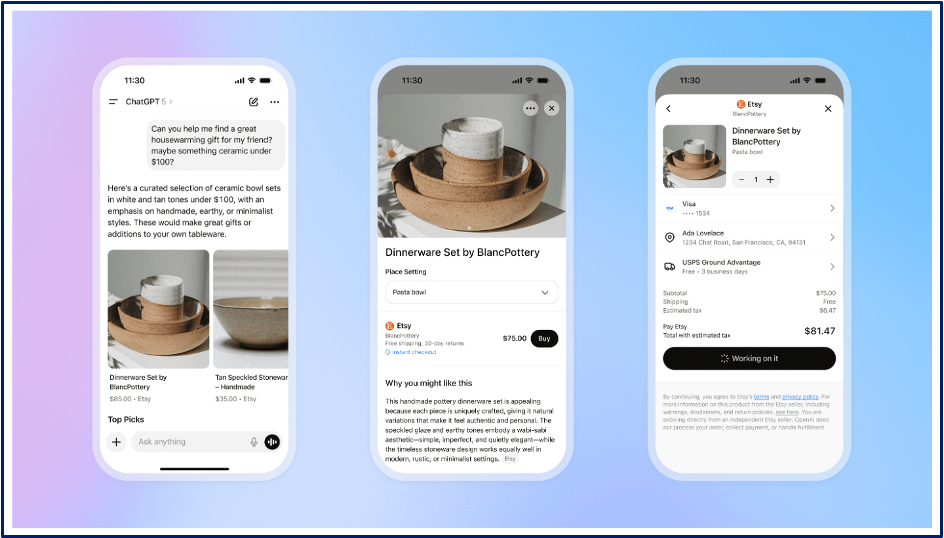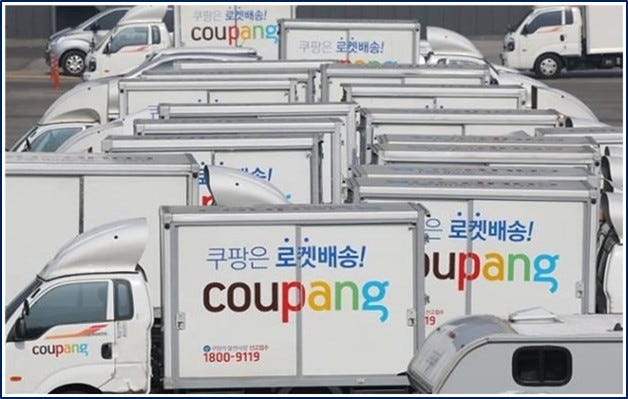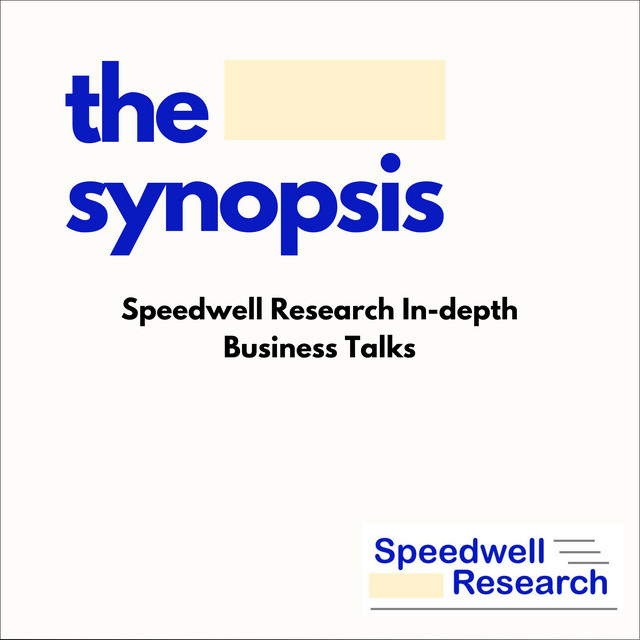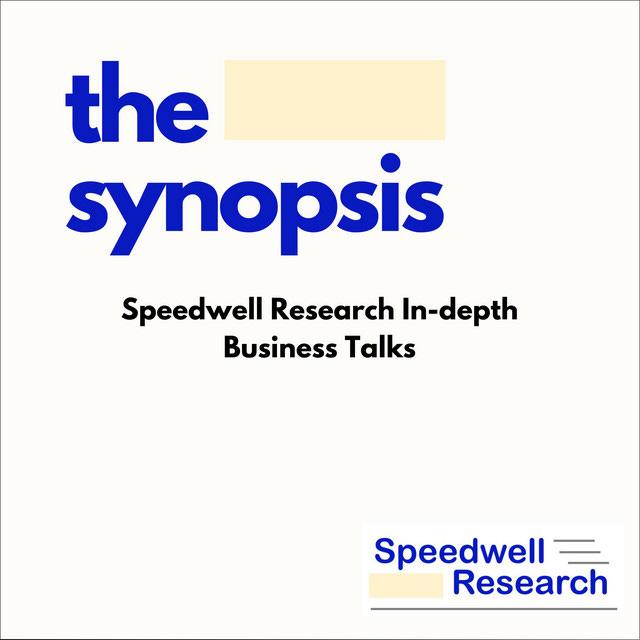The Investor's Briefing #10
Why AI Could Mean the End of the Marketplace Model, Meta's Paranoid "Vibe", Coupang's Drive to Win Taiwan
Welcome to Speedwell Research’s Newsletter. We write about business and investing. Our paid research product can be found at SpeedwellResearch.com. You can learn more about us here.
This is a weekly briefing, where we summarize key financial news in the week and recent content you may have missed. You can listen to this Investor’s Briefing on Spotify or Apple Podcasts too.
Welcome to the tenth edition of our weekly newsletter: The Investor’s Briefing.
In Financial News.
The U.S. government shutdown has delayed the September jobs report, leaving the Federal Reserve without a key gauge of labor market conditions ahead of its October policy meeting. Yet equity markets have continued to climb, suggesting investors expect the disruption to carry limited near-term economic consequences.
The absence of official payroll data comes at a sensitive time for monetary policy. Employment figures are typically one of the last major releases before the Fed meets, shaping the debate over labor market tightness and inflationary pressures. Without this data, policymakers must lean more heavily on alternative sources such as private payroll surveys, jobless claims, and regional business outlooks. Historically, the Fed has faced similar constraints during previous shutdowns, notably in 2013 and 2018–2019, but the stakes were far lower then.
Markets, meanwhile, appear largely unfazed. Brief shutdowns in the past have had only a modest impact on financial activity. Though extended standoffs can erode confidence and delay government-related spending. This week ended with the S&P 500 up 80bps, suggesting investors are focused less on fiscal uncertainty and more on structural drivers such as potential peak interest rates, robust third-quarter earnings forecasts, and continued momentum in AI.
While the shutdown underscores the vulnerability of data-dependent policymaking, market resilience suggests participants have become blase about the now semi-regular feud over the debt ceiling. Looking ahead, investors remain focused on the broader economic trajectory, with AI-driven growth and earnings season expected to dominate sentiment in the weeks ahead.
Company News.
The End of the Marketplace Model.
OpenAI announced the ability for users to complete purchases directly in ChatGPT from Shopify or Etsy merchants. This doesn’t just mean more convenience, but also a deeper integration with two ecommerce partners that themselves represent millions of merchants. Now a ChatGPT user can search in-stock inventory, or ask for AI’s help to narrow options, answer questions about the items, and complete the purchase all without leaving ChatGPT.
This is about much more than convenience though. It is about control. While this announcement may have seemed somewhat innocuous, it could foreshadow the end of the marketplace model as we know it.
Typically, marketplaces monetize by taking commission and charging merchants for more prominent placement in search results. These so called sponsored search ads can potentially be as much as half of revenues (and a larger portion of profits because of the operating leverage inherent in the ecommerce model).
ChatGPT now threatens that profit pool since it will be their model that decides what a user sees—and there (presumably) won’t be a model weight for partner’s sponsored ads. On the one hand, AI can help consumers find what they want easier, which could drive more purchases with a higher average satisfaction rating. On the other hand though, marketplaces are losing their direct consumer touchpoint, which moves them lower in the value chain.
Right now marketplaces serve two main functions for the seller: 1) marketplaces help merchants manage their online store with simple tools, including the ability to have shoppable inventory, and 2) marketplaces draw traffic and can use their search and ranking tools to help divert it to the most appropriate place.
While Etsy is a marketplace, Shopify isn’t. Instead they are more like the web infrastructure for SMB’s to run online businesses. Their advantage lies with providing the most services for merchants in an intuitive manner at reasonable prices. Consumers—by and large— never went to Shopify.com or the app to search for shops, but rather each individual business had to draw their own traffic.
In an AI world, little changes in this regard for Shopify. ChatGPT is just another channel that can generate demand for their sellers. Shopify was always relatively agnostic to how a consumer found a merchant—the important thing was that they help merchants be where ever they wanted to be to complete a sale.
In contrast, Etsy is losing the consumer touch point. If consumer behavior changes to look for, say, gifts directly on ChatGPT instead of Etsy.com (or Google, whose search results Etsy often dominants), then they will no longer be in the position to help consumers find items. This is problematic as it also means they will lose the ability to show sponsored ads as they lose the direct traffic. It could also mean in the future that reviews go to ChatGPT instead of Etsy and ChatGPT will gather data on how to make better recommendations.
While they may still need Etsy’s SKUs, overtime they could add other businesses or perhaps allow merchants to directly integrate their online catalogs into ChatGPT. Merchants historically needed Etsy because they lacked a notable brand name and couldn’t afford to sell direct under their own website. However, if the traffic comes from ChatGPT and other AI apps, then the need to be on Etsy.com will drop overtime.
A merchant will still need some simple tools to run their shop online, but these are effectively becoming unbundled from the traffic a marketplace traditionally generated. This unbundling is in favor of the AI app, who will now decide what items the user sees. The AI app could then decide to show sponsored ads on the results, or, more speculatively, add in listings from merchants that directly integrated to their site, where they take a sales commission.
In short, if you control the interface and the customer, you will be able to extract more value out of the transaction at the cost of the marketplace. In the most draconian scenario, any marketplace that can be accessed through AI and doesn’t have the leverage to draw customers directly to their site, is at risk of losing relevance overtime.
Meta Introduces Vibes, an AI-Generated Video Feed on the Meta AI App
Meta recently introduced Vibes, a new AI-driven video feed embedded within the Meta AI app. The product resembles an Instagram-style social feed but is dedicated exclusively to AI-generated video content. While not a standalone application at launch, Vibes could evolve into a platform where users and creators generate, share, and remix AI-only videos.
In some sense Vibes is a premature response to their greatest fear with AI. While Facebook may have emphasized social connection, it turned out that most of what people want is entertainment when they are online. The vast majority of time spent on social media apps is scrolling through videos and memes from strangers. TikTok was such a vicious threat not because they threatened the social graph, but because they exposed that people didn’t care that much about it.
After most people open their Facebook or Instagram and see the couple updates from their friends, they shift to consuming random entertaining content. While we don’t have exact figures, the majority of time spent on these apps is spent in entertainment, not socializing. AI may not threaten core social networking, but it does threaten these “entertainment minutes”.
The fear is that AI becomes so good it can on the spot generate content customized directly for the user with no need for billions of accounts churning out content. In this scenario, it is the best AI models that could provide the most compelling content that would win. This in turn would eat into Meta’s apps time spent and thus their ability to show ads.
However, Vibes is not an AI super intelligence app that can do that. Instead ,Meta said the initiative aims to “make it easier to find creative inspiration and experiment with Meta AI’s media tools.” Unlike Instagram or TikTok, users cannot upload their own video files; instead, all content must be created with Meta’s AI tools or adapted from existing AI-generated clips. To encourage participation, Vibes allows users to rework others’ videos, swap in different music, or modify captions. Importantly, videos generated on the platform can be cross-posted to Instagram Reels and Facebook Stories, tying experimental AI content back into Meta’s core social products.
This allows them to benefit from their existing network while capitalizing on the advancements of AI to provide more content to existing family of app users. As long as they aren’t too far behind with AI content on the platform, then the risk of exodus to other AI app for entertainment is muted.
The timing highlights how quickly AI-generated media is moving into mainstream consumer channels. Viral AI art and short videos have already demonstrated their ability to draw mass attention. Earlier this year, OpenAI’s image generator, Sora, gained traction through “Ghibli-style” artwork, while Google’s Gemini app surged to the top of Apple’s download charts with its Nano Banana AI video model. With Vibes, Meta is betting that a separate feed devoted exclusively to AI content can allow them (and their creators) to get better with AI content without totally diluting the user experience on Instagram and Facebook.
However, Meta is still relying on outside technology to power the early version of Vibes. Instead of deploying its own proprietary AI video models, the company has partnered with third-party providers, including Midjourney and Black Forest Labs. Meta executives have emphasized that internal models are in active development, suggesting Vibes may eventually serve as a testing ground for in-house AI systems. This dual approach allows the company to reiterate on the consumer product while refining its infrastructure behind the scenes.
The broader challenge is whether AI-generated video can sustain user interest beyond novelty. Critics point to the flood of low-quality generative output, often called “AI slop”, that already clutters feeds on TikTok and Instagram. While some viral content has proved engaging, much of it remains repetitive or disposable. Given how easy it is to make a deluge of AI-content, the algorithm’s natural ability to downrank poor performing content can get overwhelmed. (For example, Tiktok usually shows every video to at least 100 people, but AI can create a million versions of essentially the same video).
While Meta has a poor history of executing stand-alone apps, Vibes could be really be about learning more about how to implement AI in a test space that is isolated from FB and IG. Eventually though, it is likely that all AI content competes in the same apps against non-AI content, as is somewhat the case today.
How Coupang Plans to Compete in Taiwan (Alphasense Expert Call)
A former Coupang executive who led marketplace and retail strategy in Taiwan shared his perspective on the company’s approach to the market, the scale of the opportunity, and the challenges it faces.
First, Taiwan’s e-commerce penetration remains relatively low, only in the mid-teens as a share of total retail. The expert noted that because of this, the market has significant room to grow, potentially even doubling over time. Moreover, Taiwan’s consumer landscape resembles South Korea in many respects: a dense population, a robust logistics backbone, and a heavy reliance on convenience stores. However, competition is already intense. The expert shared that Shopee dominates order volumes but struggles with a reputation for low quality and a confusing C2C shopping experience. By contrast, Momo, backed by Fubon Financial, is known for reliable service but lacks the breadth of selection. Consequently, there is room for a differentiated, Amazon-like model that combines broad selection, competitive pricing, and reliable delivery.
Against this backdrop, Coupang has chosen a staged approach. Instead of immediately heavily investing in fulfillment infrastructure, the company started with a focused selection aimed at household decision-makers, particularly mothers, offering essentials such as diapers and snacks at low prices with next-day delivery (mirroring their initial strategy in Korea). This proved product-market fit and they have stepped up investment since. They recently launched their WOW membership, which removes free-delivery minimums, and thus drives order frequency higher. As transaction density increases, the company can then justify deeper infrastructure investments, drawing on its operational expertise in South Korea.
At the same time, Coupang faces a highly competitive landscape. Shopee remains the largest player, but its lower end brand and rising take rates have created dissatisfaction among sellers, opening the door for Coupang. Momo remains strong but is unlikely to match the same level of infrastructure investment. As a result, Coupang has an opportunity to carve out market share with its fully integrated logistics offering. While still smaller than its peers, Coupang has expanded beyond groceries into high-volume categories like electronics, steadily closing the gap with Momo.
In parallel, the company has been building its 3P marketplace, designing it to avoid Shopee’s “marketplace jungle”, as the expert called it, by offering one seller per item at the best combination of price and reliability. Coupang is using the fact that Shopee has significantly raised their take-rates to onboard frustrated sellers.
“I think the second thing that Coupang is riding on is a lot of sellers are not happy with Shopee because Shopee had increased their take rate drastically within like two and a half years’ time. Probably from 2% all the way to 7%, 8%. Consecutively, it just keep increasing. I think there’s a lot of dissatisfaction with that.” - Former Head of Retail Strategy at Coupang
He also pointed out that leadership changes reflect this determination. Founder Bom Kim has replaced much of the Taiwan management team, bringing in executives from India and San Francisco who have experience in hyper-competitive markets with Flipkart and Amazon. This expert said, “He’s there to win things. He wants people just do things the way that he wants done. He hired a team of mercenaries.” According to him, this shift underscores his belief that Taiwan can be won with the same relentless playbook that worked in Korea, provided the company has the right leadership in place.
While risks remain, it’s important to remember Coupang took Korean ecommerce dominance as a latecomer amid a hyper competitve market. As we noted in our last business update on Coupang, Bom Kim stated that “Our Taiwan offering is growing faster and stronger than even the most optimistic forecasts we set at the beginning of the year,” with revenues expected to accelerate to triple digits next year.
In sum, Coupang’s Taiwan strategy reflects its Korea logistics-heavy model. Although the path to profitability is uncertain and likely distant, the company has positioned itself as a credible challenger in an underpenetrated market, with the ambition to replicate the scale it achieved in South Korea.
This is from an AlphaSense Expert Call Interview.
You can get a free trial of AlphaSense here
Coupang 2Q25 Business Update
We changed up the format of the company section to extend the story of each company. If you enjoyed this, please drop a comment or like so we know to keep doing it in the future! Feedback is always welcomed.
Spotlight.
As the 3Q earnings season starts in the coming weeks, check out all of our 2Q25 business updates we have released to stay up to date.
2Q25 Business Updates: Meta, Copart, APi Group, Floor & Decor, AppFolio, Coupang, Axon, Airbnb, Evolution, CoStar Group, Perimeter Solutions, Constellation Software, RH, and DFH.
Become a Speedwell Research Member to gain access to all extended versions of all of our updates, as well as our library of in-depth research reports! Click here to learn more.
Below are select quotes from our most recent business updates & recaps
Coupang Intelligence Cloud Competition: “He [Bom Kim] did note that they have been building out their own AI compute infrastructure for internal needs for years. Similar to Amazon and AWS, they have toyed with the idea of offering it to external customers and have just started to test that. Given that they are very late to the market, they have formidable competitors in Google, Amazon, and Microsoft. However, vying for government business makes sense at they would have an advantage as they are a Korean business, which could quell some data concerns. They also could have more success selling to other Korean businesses because of cultural differences and a desire to multi-cloud their infrastructure.”
Coupang 2Q25 Business Update
Head of M&A at CSU on the Difference Between Private Equity and Constellation Software
Listen to the full interview here
The Synopsis Podcast.
Check out our latest interview episode with Rohan Noronha, who is a head of M&A at Constellation Software! In this interview, we talk about copycats, style drift, organic growth, and much more.
*This episode was originally recorded during an AlphaSense webinar we hosted in late July. Many thanks to AlphaSense for making this conversation possible. Listen below!
Memo of The Week.
How Pies, Proofs, and Punch Cards Hold Key Insights into the Cost of Equity
“Looking into these remarks we can gain insight into the same question asked differently: when should you deploy capital? What the punch card framework is trying to impose is artificial scarcity. When money is more abundant than ideas, there is little stopping an investor from making poor investments with low prospective returns. In fact, most financial bubbles correspond with periods of “easy money policies” when capital is most abundant. When you have the money to do something, most people think they must do something. The 20-hole punch card idea is about thinking beyond your current investment options to think about your opportunity costs across time. When good ideas are scarce and there is no competition for your capital, errors in judgement are likely to increase.”
Learn more about your true cost of equity in this memo here 👇
How Pies, Proofs, and Punch Cards Hold Key Insights into the Cost of Equity.
Company Report Snippet: Meta Platforms (META)
Copy the How, Not the What: “While Facebook hasn’t had much luck in launching standalone apps, they have found significant success in copying popular features. Snapchat’s Stories feature, in particular, was so popular that Facebook was concerned that it would suck up a lot of content from the Instagram ecosystem (whose younger speedwellresearch.com 37 demographic was closer to Snapchat users).
After several failed stand-alone app attempts, the solution Facebook arrived at was simple: launch the same exact feature in Instagram and call it the same thing so there was no confusion about what it was. Kevin Systrom would plainly acknowledge that Snapchat came up with the idea, but nevertheless their superior network helped Instagram Stories become an instant sensation and stymied Snapchat’s growth in the process.”
*This is an excerpt from our company report on META.
If you are a Speedwell Research Member, read the full report here: META
If you are not already a Speedwell Research member, you can purchase it here: META Individual Report
Upcoming.
Research
Current research report in progress: Exploratory Report on Casey’s, a convenience store and gas station chain that also happens to be the 5th largest pizza retailer in the country.
AlphaSummit 2025
AlphaSense is hosting its AlphaSummit October 6-8 in Brooklyn, New York. It is a transformative event for leaders redefining market intelligence. You will hear from industry visionaries and executives, participate in interactive product sessions and expert-led workshops, and connect with research leaders in your field. AlphaSummit is your chance to learn, network, and become part of a community reshaping the future of market intelligence.
Register Your Spot Here and Get 15% Off!
If you enjoyed this investor’s brief, subscribe so that you don’t miss a single update!
Sharing Links.
Check out Speedwell Research’s Drew Cohen’s YouTube Channel. It is focused on general investing and business content.
Other Links.
A Letter a Day: CSU President Mark Miller and Hugh Chow (2025) (link)
Massive Moats: The Wisdom of Chris Hohn (link)
Alex Morris (TSOH Research): On Consistency and Simplicity (link)
And a special thank you to Matthew Harbaugh for helping put this weekly recap together!
The Synopsis Podcast.
Follow our Podcast below. We have four episode formats: “company” episodes that breakdown in-depth each business we write a report on, “dialogue” episodes that cover various business and investing topics, “article” episodes where we read our weekly memos, and “interviews”.
Speedwell Research Reports.
Become a Speedwell Research Member to receive all of our in-depth research reports, shorter exploratory reports, updates, and Members Plus also receive Excels.
(Many members have gotten their memberships expensed. If you need us to talk with your compliance department to become an approved vendor, please reach out at info@speedwellresearch.com).














